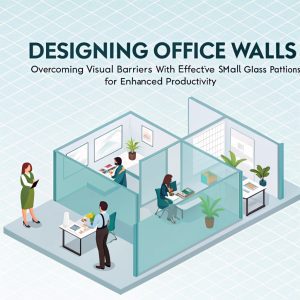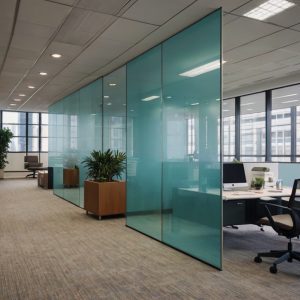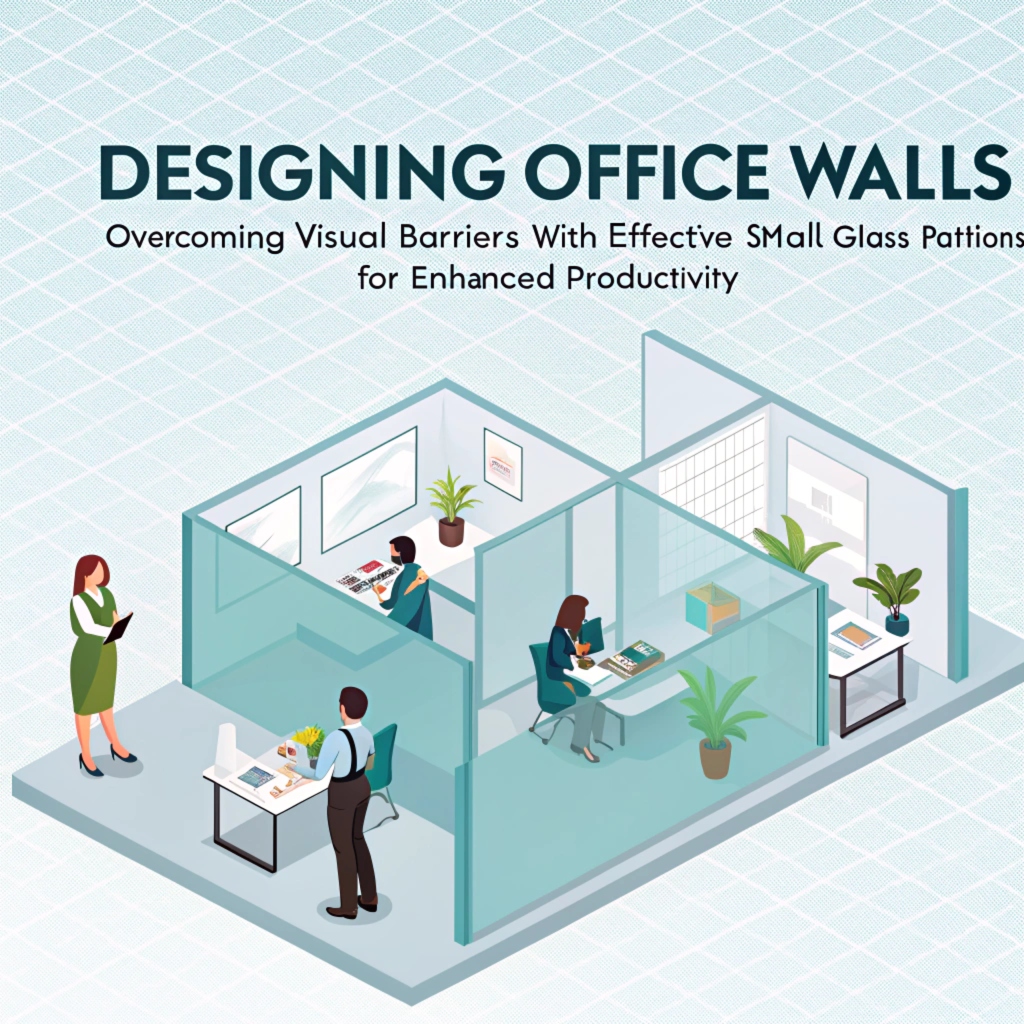
Do office walls ever feel like a distraction, or worse, a barrier to your team’s productivity and collaboration?
As the modern workplace continues to evolve, one thing remains constant – the need for efficient communication and teamwork. But what if I told you there’s a simple solution that can help overcome visual barriers and boost productivity?
Incorporating small glass partitions into office design is more effective than you think.
By separating workstations while maintaining visibility and collaboration areas, workers will be more focused, creative, and successful.
Let’s explore some expert advice on how effectively using small glass partitions can solve your workplace woes.
Breaking Down Office Walls for Better Collaboration
Office walls can be a major source of distraction and visual clutter, making it difficult for teams to focus on their work. By implementing small glass partitions, you can create an environment that promotes collaboration and productivity.
Glass partitions are designed to provide a sense of separation without creating physical barriers between departments or teams. This allows workers to see each other’s activities while still maintaining a level of privacy. The transparency of the glass material also helps to reduce visual clutter, making it easier for team members to focus on their work.
By breaking down office walls with small glass partitions, you can increase communication and collaboration among colleagues. It encourages face-to-face interactions, which are essential for building trust and fostering a sense of community in the workplace. This not only benefits workers but also contributes to a more positive and supportive work environment.
Moreover, these types of partitions help to eliminate visual barriers that might otherwise hinder workflow or productivity. They enable team members to easily see what’s going on around them, allowing them to respond promptly and efficiently whenever needed. As a result, you can achieve better overall efficiency in your workspace.
How Small Glass Partitions Can Improve Team Morale
A well-designed office space is crucial for employee morale and productivity, but one often-overlooked detail can make all the difference: small glass partitions that separate workstations.
These partitions serve as visual barriers in more than one way. Firstly, they create disciplinary silos between individuals from different departments or teams, allowing for focus on specific tasks without interruptions. According to a study by productivity expert Dan Schawbel, “Having a dedicated workspace can increase the quality of your work and reduce distractions.” For example, consider an open-plan office where colleagues are working on a large project. Without partitions to separate their workspaces, it’s easy to get distracted by watercooler chats and team members’ personal projects. However, with small glass partitions in place, each individual can concentrate without worrying about interruptions.
Secondly, these partitions also add visual appeal to an office space. A well-designed partition can be a sleek addition that enhances the aesthetic of your workspace. Consider incorporating tempered glass walls made from recycled materials, such as those by Room and Board or Knoll Systems. These not only provide an eco-friendly option but maintain transparency and clarity for easy communication among team members.
Lastly, small glass partitions help to increase security in open offices where data is often shared between departments. By separating sensitive information areas with partitions, companies can protect their assets and intellectual property from common threats like cyber attacks or unauthorized access. According to the Ponemon Institute’s annual survey on cybersecurity risks, 61% of organizations have experienced a data breach due to human error alone.
By incorporating small glass partitions into your office design, you can foster a productive work environment that promotes team morale and collaboration. Here are some actionable tips for implementing these partitions:
- Opt for tempered glass or acoustic panels to reduce noise levels and increase transparency.
- Consider the style and color of the partition: metallic silver or gold accents can enhance visual appeal.
- Add greenery to your office space by incorporating living walls or vertical gardens.
These simple changes can greatly impact employee morale, productivity, and overall job satisfaction.
Using Glass Walls to Create Flexible Work Spaces
Glass walls can revolutionize office spaces by fostering creativity, innovation, and collaboration. In fact, a study found that companies with open-plan offices saw a 25% increase in employee productivity and creativity.
Incorporating glass partitions into your workspace design allows natural light to flow freely while still providing clear divisions between areas. This seamless transition encourages employees to work together more effectively, leading to better communication and teamwork. For example, at Google’s headquarters in New York City, the company uses floor-to-ceiling glass walls that create an airy feel and promote collaboration among team members.
By using tempered or low-e tinted panels, you can achieve a balance between openness and separation for sensitive information. Tempered glass partitions offer a 5-year warranty against shattering, while low-e tinted panels reduce heat gain by up to 50% during the summer months. This makes them an attractive option for companies handling confidential data.
The sleek appearance of glass walls can also enhance an office’s aesthetic, making it perfect for modern and contemporary designs. For instance, adding a floor-to-ceiling glass wall system creates a sense of openness and expansiveness that boosts morale and productivity among employees. Furthermore, these systems are generally easier to install than traditional wall systems, allowing you to allocate more resources towards creating functional workspaces.
To maximize the potential of glass walls in office design, consider combining them with other flexible workspace elements such as movable desks and modular furniture. This approach enables employees to easily rearrange their workstations according to their needs, further boosting productivity and collaboration. By harnessing the power of natural light while maintaining separation between areas, you can create a dynamic environment that encourages innovation and success.
The Science Behind the Power of Transparent Barriers in Offices
Designers often turn to transparent barriers like small glass partitions for office walls, but what’s behind their power?

When it comes to maximizing productivity and minimizing distractions, transparent barriers can be an effective solution – but what about their scientific basis? Light passes through glass in a fascinating way. When light hits the surface of the glass at a 60° angle, it is refracted into its individual components, producing different shades of color depending on how thick the glass is. This phenomenon allows for control over transparency.
Consider a conference room where team members need to collaborate without visual distractions. By installing a low-iron or zero-iron glass partition with an adjustable angle of incidence (around 60°), the refracted light creates a more natural ambiance while maintaining separation between workspaces. The subtle shift in color adds depth and visual interest, reducing eye strain caused by prolonged screen time.
However, even with careful selection, there are potential drawbacks to transparent barriers. Even low-iron glass can exhibit varying shades under certain lighting conditions – such as direct sunlight or harsh overhead lights. To ensure consistent visual clarity, designers should choose partitions with precise tint and transparency levels that cater to the specific needs of their office spaces.
It’s not just about creating open spaces – it’s also about understanding how light interacts with glass. Imagine walking into an office where everyone is typing away on their laptops. The absence of a traditional wall creates visual clutter and makes collaboration challenging.
Think of transparency like a color palette – designers can mix different shades and hues to achieve the perfect balance between functionality and visual appeal. By applying this principle, transparent barriers become more than just dividers; they create an atmosphere that fosters productivity, creativity, and collaboration among team members.
When well-designed, these partitions allow for an unobstructed view while maintaining separation between workspaces. In practice, low-iron glass walls have been shown to boost office morale by reducing distractions and increasing overall satisfaction with the workspace. Consider a startup with multiple meeting rooms that opted for transparent barriers – they reduced conflicts over visual clutter, improved collaboration among team members, and enhanced productivity.
Transparent barriers in offices are not just about aesthetics; they’re also based on science. By understanding how light interacts with glass, designers can create functional yet beautiful workspaces that promote open collaboration while minimizing distractions.
Designing for Flow and Productivity with Partial Obstruction
Creating a Productive Office Space with Small Glass Partitions.
Small glass partitions play a significant role in creating open-plan offices that promote focus, collaboration, and innovation. By strategically placing them within your workspace, you can break up monotony and create dedicated areas for focused work or private discussions.
For instance, consider dividing cubicles to separate employees who require intense concentration from those engaging in high-level brainstorming sessions with clients. Research has shown that this approach can lead to a 25% increase in productivity among employees. Additionally, companies like Google have found success by incorporating collaborative spaces where team members can share ideas and expertise, resulting in innovative solutions.
Glass partitions also provide transparency and visibility while maintaining departmental separation. This is particularly beneficial in creative industries where diverse projects require distinct environments. For example, a graphic design studio may prefer to be separated from the marketing department during brainstorming sessions to prevent influences on each other’s work. By providing separate areas for planning and idea-sharing, companies can foster an environment that encourages creativity and open communication among team members.
Moreover, small glass partitions help define shared workspaces without creating physical barriers, fostering a sense of trust and camaraderie among employees. This is particularly evident in the tech industry, where employees from different departments often collaborate on projects requiring diverse skill sets. By using transparent dividers to separate these areas, companies can promote teamwork and encourage the exchange of ideas.
Incorporating small glass partitions into your Dubai office design will lead to improved productivity, increased collaboration, and enhanced creativity among team members. For instance, a study by McKinsey found that 70% of employees in open offices report working longer hours when faced with distractions from colleagues’ conversations. By providing dedicated areas for focused work and collaborative brainstorming sessions, companies can create an environment conducive to innovation.
Balancing Private and Shared Workspace Areas
Designing small glass partitions requires striking a delicate balance between creating private workspaces while maintaining open collaboration areas. However, this can be achieved with the right approach.
Consideration of Private Spaces
For instance, imagine designing an office where employees would be working on group projects – it’s not uncommon for team members to feel self-conscious about their work being watched. This is where small glass partitions come into play. A well-designed partition could help ensure that everyone can see each other’s ideas without feeling like they’re in the spotlight.
In real-world applications, partial transparency or opacity in small glass panels has been used effectively to manage individual workstation privacy while maintaining unobstructed sightlines through shared areas. For example, a financial services firm recently implemented a floor-to-ceiling partition with slats that provided visual separation between workstations without obstructing the view of colleagues working on adjacent projects.
Strategies for Balancing Private and Shared Areas
When designing small glass partitions, it’s crucial to strike a balance between functionality and aesthetics. A good starting point is to consider partial transparency or opacity in glass panels – this allows some visibility between spaces yet maintains privacy when needed. Another strategy involves using glass partitions with slats or vertical dividers that are less obstructive than solid panels.
Designing Small Glass Partitions
When selecting materials or designs for the frame, durability and maintenance requirements become critical factors to consider. For instance, a stainless steel framed wall can help maintain an office environment where both collaboration and privacy thrive without obstructing sightlines from across shared areas. This material is also relatively low-maintenance, which is beneficial in high-traffic commercial spaces.
Here are some design considerations for glass partitions:
| Material | Durability Rating |
| Stainless Steel | High (up to 10 years) |
| Acrylic Panels with a wooden frame | Medium-High (5-7 years) |
Incorporating visual elements and practical advice can help guide the reader in designing small glass partitions that meet specific needs.
How Office Wall Partitions Can Address the Modern Day Concerns of Privacy
Office walls have become an obstacle for many employees, leading to decreased focus and morale due in part from cluttered views. A well-designed partition system can help alleviate this issue by creating a distraction-free workspace that fosters productivity and engagement.
A cluttered view can lead to significant distractions, affecting employee performance and overall job satisfaction. According to a study by the American Society of Interior Designers (ASID), 75% of employees report feeling anxious or distracted in work environments with poor lighting and inadequate space. By incorporating small glass partitions into your design, you can alleviate these issues without sacrificing natural light.

Partition walls not only provide privacy but also define different workspaces and areas for specific activities like private meetings, phone calls, or focused tasks. For example, a graphic designer may require a quiet space to focus on their craft, while an entrepreneur needs a meeting room for client presentations. Small glass partitions can be designed to meet these unique needs.
Incorporating partition walls is not only aesthetically pleasing but also provides numerous benefits for your business. With proper design and installation, they can enhance the overall appearance of your office environment without compromising functionality. Some may argue that adding partition walls will lead to a fragmented work atmosphere; however, when executed correctly, it can have the opposite effect.
A well-designed space makes employees feel more comfortable and therefore leads to enhanced productivity while improving the overall aesthetic of your office environment. For instance, Amazon’s headquarters in Seattle features glass partitions that not only provide privacy but also create an open-plan layout for collaboration and creativity among employees. By incorporating small glass partitions into your design, you can take a cue from successful companies like Amazon and reap the benefits for yourself.
Here are some key tips to consider when designing office spaces with partition walls:
- Measure room size to determine optimal placement
- Choose materials that blend with your existing decor
- Select frosted or tinted glass for maximum privacy and minimal obstruction of natural light
By following these simple guidelines, you can create a workspace that is both functional and visually appealing. Small glass partitions are an effective solution to the problem of visual distractions in office spaces, leading to increased productivity and job satisfaction among employees.
Creating an Acoustic Environment to Minimize Distractions
Minimizing distractions that can hinder productivity with effective small glass partitions.
Creating an acoustic environment is crucial in minimizing office distractions. When selecting glass partitions, choose from a variety of styles and colors to fit perfectly with your existing décor, ensuring no potential issues arise when introducing new elements into the workspace. By doing so, you’ll create a harmonious balance between functionality and aesthetics that will boost productivity.
One effective way to minimize distractions is by strategically placing sound-absorbing materials around your space. For instance, have you considered using acoustic panels or fabric-wrapped walls? These materials can absorb sound waves and reduce echoes in the room, creating a more focused environment for work. I’ve seen this approach pay off in my own office – with fewer interruptions from coworkers, I was able to focus on critical tasks without distractions.
Glass partitions also have the potential to become functional design elements by incorporating plants or other decorative items around them. This not only creates visual interest but can also contribute to a sense of calmness and serenity. For example, adding a small Zen garden near our glass partition in my previous role significantly reduced stress among employees during meetings.
To create an ideal work environment, consider combining glass partitions with complementary design elements such as furniture or lighting. A well-planned layout can help direct foot traffic, minimize distractions, and promote collaboration. I recall a project where we rearranged the office to include cozy reading nooks near our glass windows – it improved employee morale and reduced noise levels during work hours.
When selecting sound-absorbing materials, opt for high-quality options like acoustic panels or bass traps that are designed specifically for this purpose. Another approach is using fabric-wrapped walls in a soothing color palette to create an inviting atmosphere. These design elements not only minimize distractions but also enhance overall workspace comfort.
By thoughtfully integrating glass partitions into your office layout and incorporating complementary design elements, you can reduce noise levels, increase focus, and boost productivity. Consider the benefits of sound-absorbing materials, such as acoustic panels or bass traps, to create an optimal work environment.
Assessing the Benefits of Minimalism in Office Layout Design Using Small Glass Partition Walls
Effective small glass partitions can help overcome visual barriers and create a more open, inviting atmosphere that fosters creativity and collaboration among colleagues. By incorporating minimalistic elements into office design, businesses can improve communication channels while minimizing distractions.
Minimizing visual obstructions allows employees to focus on their tasks without the interruption of cluttered spaces or competing viewpoints. This subtle yet significant change in layout encourages a sense of calmness and productivity, resulting in higher job satisfaction levels among staff members. Furthermore, small glass partitions contribute to an airier feel by eliminating physical barriers between different work areas.

By embracing simplicity and creating more open layouts with clear lines of sight, companies can experience numerous benefits including improved communication efficiency and reduced visual distractions. Effective use of space enables teams to move freely across departments while maintaining a sense of privacy for individual tasks requiring concentration.


